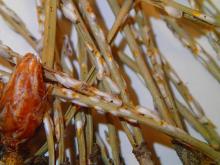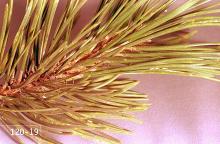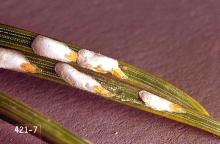Chionaspis pinifoliae
Pest description and damage Pine needle scale insects are about 0.1 inch in length. Female adults appear as elongate white scales that are found on and feed on the needles. The insects beneath the scales are reddish orange, or the scale is filled with rusty colored eggs. Heavily infested trees may appear crusted with white. Infested needles turn yellow, then brown. Twigs and branches may be killed. Repeated infestations may kill trees eventually. Pine needle scales often are found with black pine leaf scales, which are gray to black instead of white. Pine needle scales also infest ornamental pines, arborvitae, cedar, hemlock, spruce, and Douglas-fir.
Biology and life history The insect overwinters as eggs beneath the female scale cover. The eggs hatch in May or June, and the reddish crawlers migrate to a new part of the host tree or are blown or carried to new hosts. One or two generations occur, depending on location. If there are two generations, second generation crawlers are found by midsummer.
Pest monitoring Check pines that appear yellowish or unthrifty. Look for white scales protected inside the curved interior of the needle bundles. Occasionally trees are visibly white with scales. Since scale insects do not fall off, check to be sure that the scales are still present under the scale-covering or that crawlers are on the foliage before initiating pesticide application.
Management-cultural control
Keep plants healthy with proper watering. Populations are reported to build more rapidly on stressed or dusty plants.
Management-biological control
Small numbers are easily tolerated and provide food for parasitoids that keep scale insects in check. Parasitoids, lady beetles, and birds feed on scales. Holes in scales are made by exiting parasitoids. The whitish residue on the needle indicates where a scale was eaten; both are evidence of natural enemies at work.
Management-chemical control
See Table 1 in:
Chemical Control of Landscape Pests
For more information
See also "Scale insect" in:




